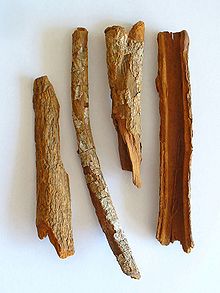Quinine
Quinine [1] is an alkaloid which can reduce fever, work against malaria, pain and swelling. The bark of the Cinchona family of trees contains quinine. Quinine can be made artificially, but this is more expensive than extracting it from the bark of the tree. This tree is found in the Andes, South America, Indonesia, and Congo.

Quinine was the first treatment for malaria, known from 1631 in Europe,[2][3] and probably much earlier to the native peoples of South America. Even today, quinine is used to treat certain forms of malaria, when other drugs fail or are unavailable. In that way, quinine is currently one of the best treatments for malaria tropica, which is caused by plasmodium falciparum. For the other forms of malaria, quinine is no longer used, as other drugs have replaced it.
History
changeQuinine relaxes muscles, and was used by the Inca of Peru to stop people from shivering. Europeans first reported using quinine against malaria in Rome in 1631.[2]
The best type of quinine used to treat malaria was found by Charles Marie de La Condamine in 1737. Quinine helped Europeans colonize Africa. A historian said that "it was quinine ... that gave colonists fresh opportunities to swarm into the Gold Coast, Nigeria and other parts of west Africa".[4][5]
Side effects
changeQuinine can cause cinchonism and even death (usually by pulmonary oedema) in some cases. Quinine can make someone paralyzed if it is injected into a nerve. It is very toxic in overdose.
Current uses
changeQuinine has a bitter taste. It was first added to drinks like Bitter Lemon and tonic water. Quinine was added to have some protection against Malaria. In China, it is sometimes added to drugs against the common cold. Quinine is also often used to add a bitter taste to food. Usually this has to be declared though. Quinine can also stimulate the muscles of the uterus. For this reason, pregnant women should not take too much of it. Sometimes it is used in combination with heroin.
Related pages
changeReferences
change- ↑ English pronunciation: /ˈkwaɪnaɪn, kwɪˈniːn, ˈkwiːniːn/
- ↑ 2.0 2.1 Fiametta Rocco 2004. The miraculous fever-tree: the cure that changed the world. Harper Collins, San Francisco. ISBN 0-00-6532357.
- ↑ Medawar P.B. & J.S. 1983. Aristotle to zoos: a philosophical dictionary of biology. Harvard, p179. ISBN 0-674-04537-8
- ↑ Conner, Clifford D. (2005). A people's history of science: miners, midwives, and 'low mechanicks'. New York: Nation Books. pp. 95–96. ISBN 1560257482.
- ↑ Porter, Roy (1998). The greatest benefit to mankind: a medical history of humanity. New York: Norton. pp. 465–466. ISBN 0393046346.
Other websites
change- From intox databank
- From inchem
- Database file on Quinine from rain-tree.com
- Quinine news page - Alcohol and Drugs History Society